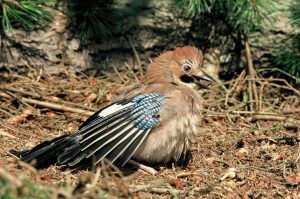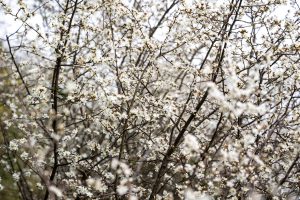A thirty year passion for feeding wild birds
Crested Tit on suet block
In some ways, feeding wild birds is an odd thing to do. They are, after all, ‘wild’ and therefore should be able to fend for themselves. But of course, none of us in the UK live in a truly wild place – I live in the Scottish Highlands and even here and despite a sense of ‘wildness ‘all around me, the landscape has been shaped by man over many centuries and that process continues today. Where once there was near-endless acres of food-rich native forest stretching from one coast to the other and only broken by lochs, rivers and the high peaks of mountains above about 1500 feet, now there is moorland for shooting, pasture for grazing, and monotonous stands of foreign conifer plantations.
And if you live in an urban area – as indeed I used to – then such an environment is about as unnatural for native birds as it’s possible to imagine. Yes some birds have adapted and cling-on to survive, but even those that have evolved to co-exist with man – most notably the House Sparrow – have struggled in recent decades and for a number of reasons. Of these, food availability, and availability at the keys times of the year (e.g. breeding season), is cited as a fundamental reason for the decline in numbers. Have you seen a decline in House Sparrows where you live? If yes, then start putting out live mealworms in a caged feeder (so larger birds don’t eat them all) during the breeding and fledgling season, and keep this up for the next few years – you’ll be amazed at what happens.
So whether it be in the Scottish Highlands or a suburb of London, then feeding the birds in your garden is no bad thing to do in the very unnatural world we all now live in.
But most of us don’t feed the birds in our garden just because they need our help; we also do so because of the sheer enjoyment we get from the spectacle. The truth is that the bird species we feed would still exist without out help – albeit, in some cases, in much smaller numbers. In any event though, these two points aren’t mutually exclusive because the enjoyment of feeding birds isn’t just about what we observe, it’s also about the satisfaction of knowing we’re helping the survival rates and breeding success of every species on your feeders.
My passion for feeding birds in my garden started over thirty years ago and with the purchase of my very first house. I’d moved from the south of England to North Yorkshire (a severe culture shock for someone in their mid-twenties...) and, having been a keen bird watcher since the age of ten, quickly took the opportunity to buy a few feeders and hang them up in my tiny garden. Why hadn’t I done this before in other places I’d lived? Not really practical in a third floor flat on the A3 in Putney.
However, thirty years ago there wasn’t quite the choice of bird food and feeders to put it in, or indeed any specialists to buy it from. The choice in my local hardware store? Pretty much peanuts and an appropriate mesh feeder, and mixed seed (though god knows what was actually in it) and a very basic tube feeder. And worth remembering that, in a pre-internet age, a computer was something that NASA had – not something we all carried around with us so we could order what we wanted and when we wanted it from online retailers.
My very first bird feeders attracted the sort of species I expected and, as I recall (and keep in mind it was over thirty years ago) included Chaffinch, House Sparrow and Blue Tit. But the species I do definitely remember was one which unexpectedly turned up to pick up the dropped seed on the ground below the feeders: a male Reed Bunting. Now that really did get me excited, and from that moment on I’d well and truly got the bird feeding bug for good.
Our monthly columnist from the Scottish Highlands
A long-time associate of Vine House Farm is Roger Hughes, who now lives in the north of Scotland and the beautiful county of Sutherland. Roger helps us with a range of business services, but he’s also a keen bird watcher, is very knowledgeable about feeding birds, is a general nature lover, and also partly earns his living from writing. He lives with his wife, Julie, and they have a small croft with a wide mix of habitats from wooded riverbank to meadow and moorland – all good for wildlife of course. So with all this in mind, Roger now writes a monthly column for the Vine House Farm website which we very much hope you’ll follow and enjoy.
In some ways, feeding wild birds is an odd thing to do. They are, after all, ‘wild’ and therefore should be able to fend for themselves. But of course, none of us in the UK live in a truly wild place – I live in the Scottish Highlands and even here and despite a sense of ‘wildness ‘all around me, the landscape has been shaped by man over many centuries and that process continues today. Where once there was near-endless acres of food-rich native forest stretching from one coast to the other and only broken by lochs, rivers and the high peaks of mountains above about 1500 feet, now there is moorland for shooting, pasture for grazing, and monotonous stands of foreign conifer plantations.
And if you live in an urban area – as indeed I used to – then such an environment is about as unnatural for native birds as it’s possible to imagine. Yes some birds have adapted and cling-on to survive, but even those that have evolved to co-exist with man – most notably the House Sparrow – have struggled in recent decades and for a number of reasons. Of these, food availability, and availability at the keys times of the year (e.g. breeding season), is cited as a fundamental reason for the decline in numbers. Have you seen a decline in House Sparrows where you live? If yes, then start putting out live mealworms in a caged feeder (so larger birds don’t eat them all) during the breeding and fledgling season, and keep this up for the next few years – you’ll be amazed at what happens.
So whether it be in the Scottish Highlands or a suburb of London, then feeding the birds in your garden is no bad thing to do in the very unnatural world we all now live in.
But most of us don’t feed the birds in our garden just because they need our help; we also do so because of the sheer enjoyment we get from the spectacle. The truth is that the bird species we feed would still exist without out help – albeit, in some cases, in much smaller numbers. In any event though, these two points aren’t mutually exclusive because the enjoyment of feeding birds isn’t just about what we observe, it’s also about the satisfaction of knowing we’re helping the survival rates and breeding success of every species on your feeders.
My passion for feeding birds in my garden started over thirty years ago and with the purchase of my very first house. I’d moved from the south of England to North Yorkshire (a severe culture shock for someone in their mid-twenties...) and, having been a keen bird watcher since the age of ten, quickly took the opportunity to buy a few feeders and hang them up in my tiny garden. Why hadn’t I done this before in other places I’d lived? Not really practical in a third floor flat on the A3 in Putney.
However, thirty years ago there wasn’t quite the choice of bird food and feeders to put it in, or indeed any specialists to buy it from. The choice in my local hardware store? Pretty much peanuts and an appropriate mesh feeder, and mixed seed (though god knows what was actually in it) and a very basic tube feeder. And worth remembering that, in a pre-internet age, a computer was something that NASA had – not something we all carried around with us so we could order what we wanted and when we wanted it from online retailers.
My very first bird feeders attracted the sort of species I expected and, as I recall (and keep in mind it was over thirty years ago) included Chaffinch, House Sparrow and Blue Tit. But the species I do definitely remember was one which unexpectedly turned up to pick up the dropped seed on the ground below the feeders: a male Reed Bunting. Now that really did get me excited, and from that moment on I’d well and truly got the bird feeding bug for good.
Our monthly columnist from the Scottish Highlands
A long-time associate of Vine House Farm is Roger Hughes, who now lives in the north of Scotland and the beautiful county of Sutherland. Roger helps us with a range of business services, but he’s also a keen bird watcher, is very knowledgeable about feeding birds, is a general nature lover, and also partly earns his living from writing. He lives with his wife, Julie, and they have a small croft with a wide mix of habitats from wooded riverbank to meadow and moorland – all good for wildlife of course. So with all this in mind, Roger now writes a monthly column for the Vine House Farm website which we very much hope you’ll follow and enjoy.


